Marine
Life Society of South Australia Inc.
Newsletter
August
2005 No.
324
“understanding, enjoying & caring for our
oceans”
Next Meeting
This
will be held at the Conservation Centre, 120 Wakefield Street, Adelaide
on Wednesday
August 17th commencing at
7.30pm.
Our
speaker will be Rosemary Paxinos who will be discussing Marine
Planning.
Contents
How you can
identify the most popular whale species off our coast (SA
Whale Centre)
Diving
the Apple Isle Part 3 (Chris Hall)
June
Long Weekend photo montage (Kevin Smith, Chris Hall, Mark Kaehne)
ARTICLES
Newsletter
and Journal articles are still needed. Please send any contributions in by
Email, letter or give to me at a Meeting.
2006
Calendar
This
is now available. AUS$8 to members and AUS$10 to non
members. Please buy as many as possible and also sell to anyone who
is interested.
We almost sold every
2005 calendar! A wonderful
effort.
People
who have seen the new edition say it is our best yet.
This
Newsletter
The hardcopy of the Newsletter is in black and white as usual. If members prefer a colour PDF version then please email me.
How you can identify the most popular whale species off our
coast
(Courtesy SA Whale
Centre:
www.sawhalecentre.com)
Aside from our
beloved Southern Right whale, a few other whale species seem to be the favourite
subjects of school projects and general interest: Humpback, Sperm whales and
Orcas.
Each species
can be sighted in SA, and you can tell them apart easily by comparing the shape
of their blow and the size and shape of their tail flukes and pectoral
fins.
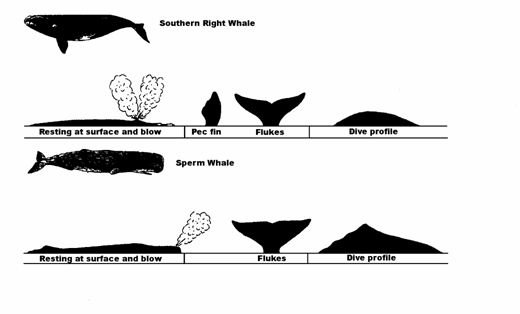
HUMPBACK
WHALES
Humpback
whales are found in all oceans of the world and grow to an average length of 15
metres. They have the longest flippers of all the whales, which make up to
one-third of the total body length. The upper body colour is black while the
underside of the flippers, belly and flanks can be white or black. The tail has
a ragged edge and on the head are bumps and knobs, called tubercles, with
barnacles growing on them.
Humpback
whales got their common name from the way they dive: when they prepare for
a dive they raise and bend their back, emphasising the hump in front of the
dorsal fin. Because humpback whales are slower swimmers and very curious, they
were easy prey to both the early and modern whalers, and the population was
eventually decimated by whaling. They are now fully protected in Australian
waters.
Humpback
whales eat krill and small schooling fishes such as herring, mackerel and
capelin.
They have a
unique and fascinating method of catching their prey called “bubble netting”.
The whale dives below a school of fish blowing a stream of bubbles from its
blowhole. As the bubbles rise they form a column that surrounds the fish
and forces it to the surface. With mouth open, the whale swims up through the
column, engulfing the fish and many litres of water. A whale can adjust the size
of its “net” to hold prey of varying size.
In the
breeding season, vigorous males “sing” long complex “songs”. A song is a
mixture of sounds including moans, cries, clicks, squeaks, roars, whistles
and other strange noises. It can last from 5 to 30 minutes, and is often
repeated identically for hours. It is thought that songs maybe used to lure
females or frighten males away.
Humpback
whales are considered to be one of the more gentle whales but can become very
aggressive when trying to win the affection of a female. They will head lunge,
head butt, tail slap, physically displace, charge and ultimately strike their
rivals. Although wounds maybe caused during this activity they are usually only
superficial.
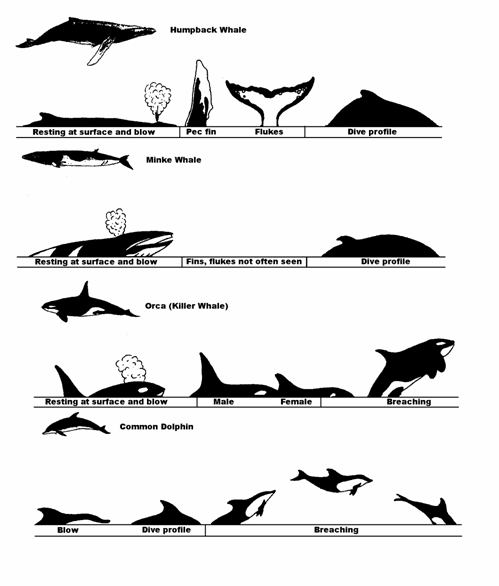
SPERM
WHALE
Sperm whales
are the largest of the toothed whales. Males can reach a length of up to 18
metres and weigh approximately 45 tonnes,
while females are smaller and average about 11 metres. Sperm whales are
dark-brown or dark-grey in colour and their skin is of a rippled,
corrugated appearance. Their blowhole is situated on the left side of the snout
so that when they blow it is at an angle reaching up to 5 metres high. They are
found around the deeper waters off continental shelves all around the
world.
Sperm whales
were named as such because in early whaling days it was mistakenly thought that
the white, waxy substance produced in their huge box-like head was part of
the reproductive system.
Sperm
whale oil was once the single most important product of commercial whaling.
Spermaceti oil is very rich and preferable to other oils because of its purity,
lubrication and speed that it can liquify. It was used for making candles,
cosmetics, soaps, detergents, machinery oil as well as many other products.
The ivory
teeth of sperm whales were once used for buttons, piano keys, markers in games and also as a decorative form of
artwork known as Scrimshaw. Sperm whales were one of the most heavily
exploited whales and the last whale taken in Australian waters was at Albany,
Western Australia, in 1978.
The main diet
for Sperm whales is squid and fish. Large males routinely dive to 800 metres or
more and have been recorded down to 3,000 metres. They can remain submerged for
up to 90 minutes and the longest recorded dive last 2 hours and 18
minutes.
ORCAS
Orca whales
are also known as Killer whales, and are regarded as the ocean's top predator.
These toothed whales hunt in packs, and feed on a wide range offish as well as
seals, dolphins, other whales, including the giant Blue whale, and sea birds.
Killer whales live in ‘pods’ or family units, with up to 40 animals in each pod.
They tend to stay together for life, although sometimes a
very
large pod will
split into two.
Killer whales
are found throughout the world’s oceans, and are recognised by their striking
shiny black-and-white skin pattern. Males can reach a length of up to 9 metres,
while females are smaller, and measure about 7 metres. Calves are born at an
approximate length of 2 metres.
Male Killer
whales are distinguished by their very erect, tall and sharply triangular dorsal
fin. The female dorsal fin is shorter and slightly curved. The flippers are
broad and paddle-shaped. Killer whales are very active, being robust and fast
swimmers, that frequently breach and spy-hop.
Even though
Orcas were not hunted commercially, they were known to have assisted
whalers by alerting them to the passage of other whales. They would lob tail,
breach and then harass and herd other whales before and during
capture.
For their
reward the whalers would leave the tongue and lips for the Killer whales, items
which they regard as delicacies.
Edithburgh 2005 June Long Weekend
underwater pictures taken at
either Klein’s Point,
Edithburgh or Wool Bay Jetties
by Kevin Smith, Chris Hall
or Mark Kaehne.




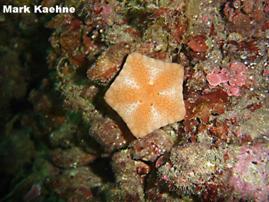
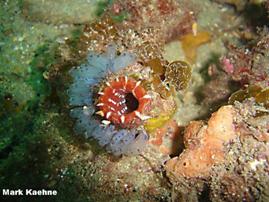

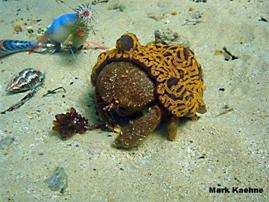
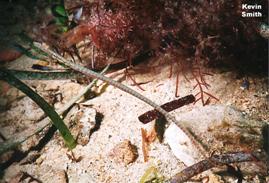
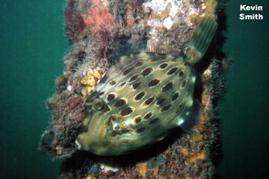
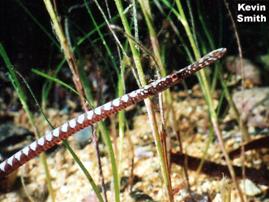
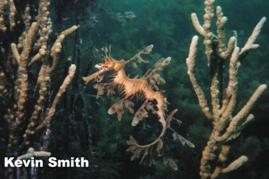
by
Chris Hall
Part
3
Sunday
morning and we awoke refreshed as we’d had an extra hours sleep as daylight
saving had finished. This also had to be our last day of
diving.
Our dive
group as the most experienced and keen were to dive the Sponge Gardens at a
location called the Thumbs a 50 metre dive if so desired. To facilitate the
three groups so that we’d all get two dives we were bussed around to Fortescue
Bay to meet the first group after diving the giant kelp
forests.
On the
way around to Fortescue Bay, Pete deep in conversation with the driver’s
passenger missed the turn off and we ended up on a bit of an unplanned
excursion. Eventually we arrived just before the boat turned up so no harm
done.
Just as
we started to kit up down came the rain and with no shelter it reminded me of
those many times in Ireland I got wet before the dive. However nothing beats the
second snorkel I did after my pool training. Standing at Sandycove getting
changed and stripped down to my bathers it started to snow. No wonder I’m back
in Oz. Anyway I digress.
By the
time we got to the dive site the skies had cleared and as we were diving in the
lee of rocks it was quite calm. Mick briefed us about the dive and we entered
the water being curiously observed by a couple of seals. The plan was to dive as
deep as we wanted because evidently the deeper you went the better the sponges.
I dived to about 33 metres; others dived to forty to log their first 40 metre
dive. One pair reached the bottom at 48.8 metres and confirmed that the marine
growth does get better the deeper you go, well at this site at least.
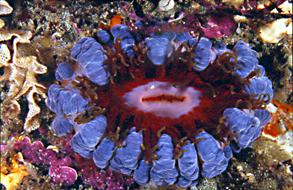
I found
some interesting sponges and other invertebrates to photograph and slowly made
my way back up the cliff face. The colour and abundance of sponges, etc. was
just mind blowing. About half way up I noticed a fish I hadn’t seen before a
stars and stripes toadfish, at least that’s what I believe it to be. Evidently
it lives in deeper water and is not commonly seen by divers.
I then
headed off to photograph a sea star when I was nearly bowled over by a fur seal.
It was trying to bite my fins and as I rolled out of its way I managed to get a
close up shot of the offending culprit. It was then joined by another seal as
they both played and frolicked with the divers. As always the dive ended all too
quickly. Another great dive especially as we’d been entertained by these two
playful fur seals and the colour of the marine growth. I was the last to surface
and as I finned back to the boat I reflected on the five brilliant dives I’d had
so far. It also was good to have great visibility because around the parts of
South Australia I do most of my diving 10 metres is considered
good.
Having
left the Sponge Gardens behind it was back home for
some food and a chance to relax before the next dive.
Again we
were bussed to Fortescue Bay to dive the kelp forests. The trip is quite
pleasant especially as you leave the main road and travel by dirt road through
native forest.
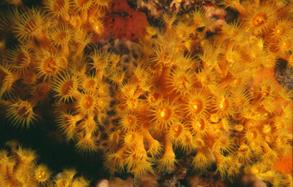
This was
to be our last dive so Gary let us do our own thing. It was a reasonably shallow
dive at 12 metres and the visibility was about 8-10 metres. It was quite an
interesting dive with quite a lot of marine life and kelp rising from the bottom
to the surface 10 metres or so. I was looking for some weedy seadragons but was
out of luck. An ornate cowfish seemed to follow me around or it may have been a
number of different ones. During the dive I spotted a draughtboard shark and
watched it slowly disappear into the distance. One unusual thing I noticed about
the kelp was that some of it had come loose from the sea bed and was just
hanging there as if suspended. Their massive holdfasts 1 or 2 metres off the
bottom were swaying in the current. After about 60 minutes or so I was getting
cold so back to the boat. As usual a couple of guys had spotted some weedies.
Later on I learnt that someone on a previous dive had seen a red velvetfish.
They are not very common.
With the
diving officially over it was decided to go to Dunalley for a meal at the pub.
On the way there we saw some terrestrial fauna namely kangaroos, wallabies and
bettongs. On the way back some were lucky enough to see a Tasmanian
devil.
The
evening meal was pleasant and the company entertaining as we swapped stories of
our three days of diving. Plans were made for the following day and it was
decided that anyone that wanted to dive the next morning could do so at an extra
cost. Needless to say my group decided on the extra dive. Most of the others had
opted to tour Port Arthur which about 30 kilometres down the road from Eaglehawk
Neck. I had been on a previous visit to Tasmania so I was happy to fore go the
tour.
Port
Arthur was established in 1830 as a penal colony to replace Sarah Island. It was
considered a harsh and brutal place and many Irish were sent there as convicts,
both political and felon alike. Port Arthur operated as a penal colony until
1887 and now is a major tourist attraction.
Easter Monday and a
nice bright but cold morning. Into the ‘troop carrier’ for the last time and down to the
harbour.
Gary
took us out to Waterfall Bay. There was one more cave to dive which didn’t need
a guide to dive. I opted to go in search of some dragons. I spent the whole of
my dive looking for those elusive creatures however to no avail. I had an
enjoyable dive and used up my roll of film taking photos of globefish, toadfish,
anemones and anything else but no weedy seadragons. I think I surfaced with
about 10 bar of air. Back in the boat I was informed the others had seen a male
weedy seadragon with eggs. Obviously my luck wasn’t in. For those that don’t
know, seadragons and most seahorses, the males carry the eggs until they hatch.
I couldn’t really complain as I’d had seven marvellous
dives.
When we
got back to the dive centre it was time to clean all our gear and start to pack
what we could for the trip back to Hobart and then Adelaide. Having completed
these tasks it was some free time to relax and reflect on a great weekend of
diving.
Our last
evening in Tassie and it was arranged to meet at a restaurant in Taranna a few
clicks down the road, however the message was late and so was dinner. All the
same it was a lovely meal to compliment a very enjoyable few days of diving and
socialising.
Tuesday
morning finally arrived with regret, so to alleviate the disappointment of
leaving; we all had a bit of a sleep in. Once bags were packed and loaded on the
transport it was time to say our good-byes and thank-yous to our hosts at Eaglehawk Dive
centre.
Gary
suggested a leisurely trip back to Hobart and there weren’t any complaints. We
stopped at Dunalley for a coffee and then took the long way back to Hobart via
the coast on dirt roads. Lovely scenery and views as we passed
farms and small coastal settlements.
Pete
made a small detour via the oyster farm and visitors centre, where we got some
lovely fresh oysters and a few gifts for our friends and family back in
Adelaide.
At
Hobart airport we unloaded the gear and said our final farewells to our drivers.
An hour later we were on our way back to Adelaide and the ‘Apple Isle’ was ten
thousand meters below us.
It was such a
fantastic trip that I’m planning to return later this year.
PICTURES
by Chris Hall